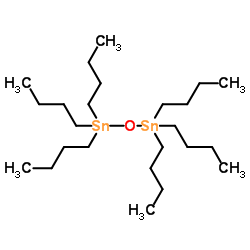Tributyltin oxide

Tributyltin oxide structure
|
Common Name | Tributyltin oxide | ||
|---|---|---|---|---|
| CAS Number | 56-35-9 | Molecular Weight | 596.105 | |
| Density | 1.17 g/mL at 25 °C(lit.) | Boiling Point | 474.8±28.0 °C at 760 mmHg | |
| Molecular Formula | C24H54OSn2 | Melting Point | -45°C | |
| MSDS | Chinese USA | Flash Point | 241.0±24.0 °C | |
| Symbol |



GHS06, GHS08, GHS09 |
Signal Word | Danger | |
|
Rapid screening and identification of multi-class substances of very high concern in textiles using liquid chromatography-hybrid linear ion trap orbitrap mass spectrometry.
J. Chromatogr. A. 1386 , 22-30, (2015) A new analytical method was established and validated for the analysis of 19 substances of very high concern (SVHCs) in textiles, including phthalic acid esters (PAEs), organotins (OTs), perfluorochemicals (PFCs) and flame retardants (FRs). After ultrasonic e... |
|
|
A novel toxicogenomics-based approach to categorize (non-)genotoxic carcinogens.
Arch. Toxicol. 89 , 2413-27, (2015) Alternative methods to detect non-genotoxic carcinogens are urgently needed, as this class of carcinogens goes undetected in the current testing strategy for carcinogenicity under REACH. A complicating factor is that non-genotoxic carcinogens act through seve... |
|
|
A draft map of rhesus monkey tissue proteome for biomedical research.
PLoS ONE 10 , e0126243, (2015) Though the rhesus monkey is one of the most valuable non-human primate animal models for various human diseases because of its manageable size and genetic and proteomic similarities with humans, proteomic research using rhesus monkeys still remains challengin... |
|
|
Blocking the association of HDAC4 with MAP1S accelerates autophagy clearance of mutant Huntingtin.
Aging (Albany. NY.) 7 , 839-53, (2015) Autophagy controls and executes the turnover of abnormally aggregated proteins. MAP1S interacts with the autophagy marker LC3 and positively regulates autophagy flux. HDAC4 associates with the aggregation-prone mutant huntingtin protein (mHTT) that causes Hun... |
|
|
Phototactic behavior in Daphnia magna Straus as an indicator of toxicants in the aquatic environment.
Ecotoxicol. Environ. Saf. 67(3) , 417-22, (2007) In this study, the phototactic behavior of Daphnia magna was investigated as a possible bioindicator for the following 11 chemicals commonly found in the aquatic environment: benzo(b)fluoranthene, mercury (II) chloride, dimethoate, lindane, linuron, MCPA, TBT... |
|
|
Acclimation and adaptation to common marine pollutants in the copepod Tigriopus californicus.
Chemosphere 112 , 465-71, (2014) Establishing water quality criteria using bioassays is complicated by variation in chemical tolerance between populations. Two major contributors to this variation are acclimation and adaptation, which are both linked to exposure history, but differ in how lo... |
|
|
Fascin is a circulating tumor marker for head and neck cancer as determined by a proteomic analysis of interstitial fluid from the tumor microenvironment.
Clin. Chem. Lab Med. 53 , 1631-41, (2015) Head and neck cancer (HNC) is a prevalent cancer worldwide; however, clinically useful tumor markers for HNC have not been identified. Here, we aimed to identify secretory proteins from the tumor microenvironment as candidate circulating tumor markers.Samples... |
|
|
Effects of new antifouling compounds on the development of sea urchin.
Mar. Pollut. Bull. 44(8) , 748-51, (2002) Tributyltin oxide (TBTO) has been used worldwide in marine antifouling paints as a biocide for some time. However, it produced toxic effects, especially in marine water/sediment ecosystems. Consequently, its use in antifouling paints has been prohibited in ma... |
|
|
Histopathological effects of chronic aqueous exposure to bis(tri-n-butyltin)oxide (TBTO) to environmentally relevant concentrations reveal thymus atrophy in European flounder (Platichthys flesus).
Environ. Pollut. 157(10) , 2587-93, (2009) Although the use of tributyltin in antifouling paints has been banned, this compound is still a serious pollutant of the marine environment. This paper describes a unique study in which European flounder (Platichthys flesus) were chronically (8 months) expose... |
|
|
Effects of antifouling paint components (TBTO, copper and triazine) on the early development of embryos in cod (Gadus morhua L.).
Mar. Pollut. Bull. 44(10) , 1142-8, (2002) To assess the risk of antifoulant use to the commercially important cod (Gadus morhua L.), fertilised cod eggs were exposed to triazine, copper and TBTO singly or combined in laboratory tests with running seawater. At the highest tested concentrations (11.5 m... |